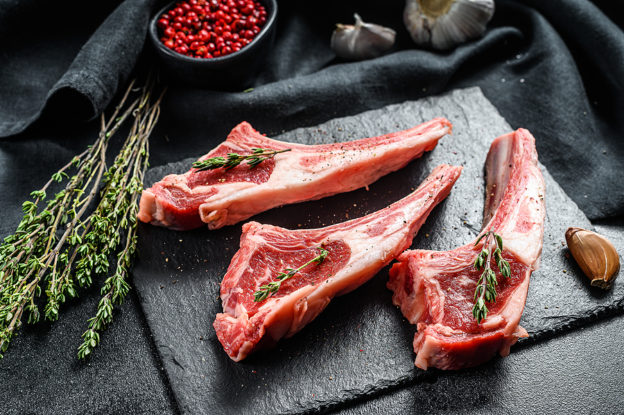By David Blyweiss, M.D., Advanced Natural Wellness
December 25, 2020
I like meat.
Perhaps once a week, I’ll sit down to a delicious meal with one of my favorite meat dishes…
It might be braised lamb cooked to perfection. Or, I’ll try a beautiful piece of salmon beside some delicious grilled veggies. Then, there are the nights where I’ll cook up some bison and pile it high with toppings for a burger.
Even though I often preach about eating mostly veggies, I do love a quality piece of meat on occasion. That’s why I wanted to clear up some confusion on when and how meat should be enjoyed in your own home.
Call these the “10 Commandments of Meat” if you’d like. These principles will help you create the right balance of meat in your diet so your body can stay healthy for years to come.
Rule #1: Cook your meat properly.
At first glance, this looks like a warning against under cooking. But actually, I’m trying to warn you about over cooking your meat.
You see, when you char-grill your chicken breasts and burgers on the grill, you’re introducing your body to many cancer causing substances. [1]
For instance, that black crispy bit on your chicken actually contains substances called AGEs. They cause damage to your body’s cells and are strongly linked to diabetes, Alzheimer’s, and muscle-wasting.
Other substances like PAHs and HCAs increase your risk of colon, pancreatic, breast, and prostate cancers.
So, if you do choose to grill your foods, make sure they are well-marinated beforehand. This extra moisture will keep the meat from turning black and crispy quite so fast.
MD Exposes the Hidden Danger to Your Eyes

When your eyesight starts to fail, it's a real problem. Suddenly you can't go to the grocery store... you can't get to the doctor if you have an emergency... you can't meet your friends for dinner…
Your "regular" doctor doesn't have time to keep up with the latest research. And the same goes for eye doctors. They go to school to learn how to fit you for glasses and contacts, but have no way of preventing the damage and loss of eyesight that threatens your freedom and independence.
Let me show you something that explains a LOT about how your eyes work.
In my FREE Special Report, I'll show you a HUGE, untapped resource for your eyes that safely and naturally restores clear, effortless eyesight.
Click here to get started...
I like to marinate my meats the night before in a mixture of olive oil and herbs. Lemon is another great option for marinating because it cuts down on the formation of AGEs, PAHs and HCAs during grilling.
Rule #2: Don’t go for those cheap meats at the grocery store.
You have many options when it comes to buying meat at the grocery store. What you may not know is that these options are not all equally safe.[2]
Some commercially raised livestock are pumped full of antibiotics and hormones while fed a genetically modified diet of corn. Remember, anything eaten by the animal, is also eaten by you.
This overuse of antibiotics is pretty concerning. About 80% of all antibiotics used here in the U.S. is used on farm animals. This fuels antibiotic resistance, and a gut microbial loss of diversity with its’ attendant downstream effect on the health of us humans too.[3]
Personally, I always go for organic, grass fed meat. My absolute favorite is meat from New Zealand or Iceland because these animals are well-treated and are free from hormones and antibiotics.
This goes for beef, pig, lamb, or poultry. Look for the options that are pasture-raised and organic.
Rule #3: Beware the franken-meats!
While you’re thinking about your meat selection, I’d encourage you to avoid another super market staple… the processed meat aisle!
It’s filled with things like hot dogs, bologna, sausages, and processed patties. But remember, processed meats – especially when cooked at high temperature – are associated with an increased rate of prostate cancer. [4]
In fact, it only takes about 50 grams of processed meats (that’s two sausage patties with your breakfast) to increase your colorectal cancer risk by 18%.[5]
Rule #4: Bison is your friend.
While you’re wandering the red meat portion of the grocery store, consider this beef alternative with many advantages… bison!
It has a similar flavor to beef, but might be a little bit richer or sweeter to your tongue. Bison is delicious with wine, shallots, mushrooms, and rosemary.
It’s also healthier than beef with five times less saturated fat and a better nutritional profile.
Rule #5: Rethink meat as the “main” dish in your dinners
Meat doesn’t need to be at the center of your plate every single meal. In fact, I recommend you only make 15% of your diet contain meat.
The World's Quickest Solution for Ending Prostate and Urinary Misery
This has recently been revealed to be one of the only real breakthroughs in prostate health.
The seeds of a strange fruit (sometimes called "Chinese Apples") hold powerful phytonutrients that are a revolution in prostate health.
In fact, UCLA and Veterans Administration research have now proved this to be true.
Not only that, but it may be the worlds quickest solution for ending prostate misery.
Simply stated, these phytonutrients represent a huge step beyond beta sitosterol, saw palmetto, and other phytosterols alone.
Simply click HERE if you want to have fast prostate relief...restful, uninterrupted sleep...no more constant "urges to go"...enhanced virility...and optimal prostate support for life.
That is plenty. The other 85% should be whole plant-based foods.
Rule #6: Impossible meats aren’t always the answer.
The grocery store shelves and restaurant menus are starting to fill up with meat substitutes. They’re not all bad.
From time to time, I might enjoy an Impossible Burger piled high with lettuce, tomato and onion. This is one of my favorite things to get at the Cheesecake Factory.
But be a little wary…
Just because something is made from plants doesn’t mean it’s automatically a “health food.” Some of these meat substitutes are just ultra-processed junk.
They’re filled with things like soy and pea protein isolate, methylcellulose, calcium alginate, xanthan gum, and other strange ingredients. So, eat these types of meat alternatives sparingly.
Rule #7: From the sea… not the fish farm.
If we’re walking through the seafood section of your store, you should be just as selective. Farm-raised fish are similar to those commercial meats I mentioned before. They are filled with fungicides, pesticides, and antibiotics. The only positive I can see for them at this moment, is that they’re not ingesting the tons of microplastic fouling the ocean.
Fish near the top of the food chain also carry a higher load of mercury and PCBs. You’ll find this in things like shark, swordfish, and albacore tuna.
Instead, go for smaller fish like wild-caught Pacific halibut, mackerel, Alaskan salmon, sardines, herring, rainbow trout, and flounder. If you’re a fan of tuna fish salad go for the light tuna with much less mercury than albacore.
My favorite way to eat fish is a toasted bagel topped with cream cheese and nova. Then, I add a thick slice of onion and a sliver of tomatoes.
Rule #8: Get your protein from a variety of sources.
By this point in my rules, you’re probably wondering how you’ll get enough protein with just 15% of your diet containing meat…
Well, you actually need a lot less protein as you get older. I recommend 0.8 grams per kilogram of body weight. For the average person, that equals about 70 grams of protein per day.
Get your protein from a variety of sources including meats, dairy, nuts, and grains like quinoa.
Rule #9: Be creative to rewire your meat habits.
If these commandments are new to you, then take things one step at a time. I suggest you start slow by trying out “Meatless Mondays.” If that feels good, then maybe add “Meatless Wednesdays and Fridays” as well.
Or, you could focus on one or two meatless meals a day and then allow yourself to eat meat on the third meal. International cuisine with lots of vegetarian meals is another great way to go. I love Indian and Thai cooking for this.
Rule #10: Balance your diet with Rainbow Foods.
The foods you eat will directly influence your gut microbiome.[6] Eating too much meat upsets the balance of bacteria in your gut. This can lead to things like inflammation, heart disease, diabetes, stroke and obesity.
That’s why you should be sure to balance out your meat meals with plates rich in colored fruits and vegetables. These nutrient-rich foods will feed the “good bacteria” in your gut so they can thrive.
Then, your health will thrive too!
Sources:
[1] Phillips DH. Polycyclic aromatic hydrocarbons in the diet. Mutat Res 1999;443:139–47.
[2] Supermarket Meat Still Superbugged, Federal Data Show. Environmental Working Group. Jun 2018.
[3] Stop using antibiotics in healthy animals to prevent the spread of antibiotic resistance. News Release. World Health Organization. Nov 2017.
[4] John, Esther M., et al. “Meat consumption, cooking practices, meat mutagens, and risk of prostate cancer.” Nutrition and cancer 63.4 (2011): 525-537.
[5] Cross AJ, et al. A large prospective study of meat consumption and colorectal cancer risk: an investigation of potential mechanisms underlying this association. Cancer Res. 2010 Mar 15;70(6):2406-14.
[6] David LA, et al. Diet rapidly and reproducibly alters the human gut microbiome. Nature. 2014 Jan 23;505(7484):559-63.






